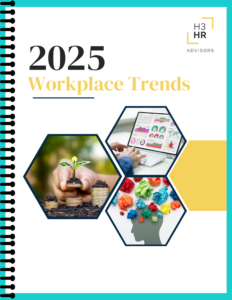Labor Market Focus: Older Workers Increasing in Numbers and in Earnings
January 3, 2024
While most of the news reporting and analysis of the US Labor Market tends to focus on the “headline” numbers like the unemployment rate, monthly gains/losses in total jobs, Labor Force Participation rates, and aggregate US job openings, there are probably hundred of other interesting and important labor market data points that are worth our consideration. Some of these, while meaningful, I suspect are not well known by casual labor market observers and HR and talent professionals. In this Labor Market Focus series on H3 HR Advisors Insights, I want to explore some of these under the radar labor market elements, and share some ideas on how understanding them can help inform and enable HR and people strategies.
This month, we examine the the growing participation and relative earning power of older workers in the labor force – those persons 65 years old and up. Long story short, they are working more than in the past, and their earnings have climbed relative to the rest of the labor force. According to a recent report titled “Older Workers are Growing in Number and Earning Higher Wages” from the Pew Research Center:
Roughly one-in-five Americans ages 65 and older (19%) were employed in 2023 – nearly double the share of those who were working 35 years ago. In 2022, the typical worker age 65 or older earned $22 per hour, up from $13 in 1987.
Additionally, the Pew Research report notes that older workers are logging more hours on the job, tend to have more advanced educational credentials than in the past, and are more than twice as likely to be self-employed (23% of older workers), than workers aged 25 – 64 (10% self-employed). When considering these factors – more older workers participating in the labor force, the trend of larger than overall wage growth for older workers, and their comparatively greater levels of education, we see that older workers overall contribution to the US economy is increasing, In 2023, workers 65 and older accounted for 7% of all wages and salaries paid by U.S. employers. That is more than triple the share in 1987 (2%).
So, what are some considerations and implications for HR leaders and talent professionals when assessing the growing role and influence of older workers? In a labor market environment with slowing but still relatively high overall job openings, (just shy of 9 million as of November 2023), and the unemployment rate remaining below 4%, organizations can’t overlook the older workforce – and in some instances may want to both increase their outreach to this group of workers, and implement programs, workplace accommodations, and policy updates to strengthen retention of existing older workers.
Here are five ways HR leaders can more effectively position their organizations to attract, retain, and engage older workers:
Offer flexible work arrangements: This can include remote or hybrid work arrangements, job sharing, or part-time work, which can help older workers balance their work and personal lives. While these kinds of flexible arrangements can benefit workers of any age, they may be of particular relevance and importance to workers age 65+, as many are interesting in scaling back their work lives somewhat, but are still interested and engaged and want to remain relevant in the professional world. Far more older workers now say they plan to reduce their working hours in preparation for retirement than a generation ago. Managing the transition to fewer hours might come through working part-time, self-employment, or doing freelance work. Smart organizations will embrace flexibility in as many forms as possible to attract and retain older workers.
Provide training and development opportunities: Employers can offer training programs to help older workers learn new skills and technologies, which can help them stay productive and engaged in their work. With modern technologies like Generative AI becoming so pervasive and important in workplaces, organizations should emphasize development opportunities that help older workers remain current and engaged. Some large organizations have developed dedicated offices for career services exclusively for use by older employees which offer custom training programs, job matching support, and individual consultation services for senior workers.
Create an age-friendly work environment: Employers can make changes to the physical work environment, such as improving lighting, reducing noise levels, and providing ergonomic equipment, to help older workers stay comfortable and safe on the job. Even in jobs that seem less-suited for older workers, steps can be taken to make work more accessible for these workers. For example, For example, in its Dingolfing, Germany plant, BMW hires older workers on an auto assembly line with accommodations for their age such as larger computer screens, special shoes, and chairs for some operations.
Tailor benefits, health and wellbeing programs: Employers can offer health and wellness programs, such as exercise classes or stress management workshops, to help older workers maintain their physical and mental health. Not surprisingly, older workers will face more physical health challenges than will their younger counterparts. HR leaders can take special steps to ensure company benefits and wellbeing programs adequately address chronic conditions such as arthritis, diabetes, heart disease, and more. It is crucial for wellbeing programs to incorporate initiatives that promote physical well-being in many forms tailored to the older worker. Consider offering age-appropriate fitness classes, health screenings, and ergonomic assessments to prevent workplace injuries to older workers.
Provide financial planning and retirement resources: Employers can offer financial planning and retirement resources to help older workers plan for their future and make informed decisions about their retirement. For older employees approaching retirement, financial wellness often becomes a significant concern. Many individuals may be uncertain about their financial future, making it essential for employers to provide guidance and resources. Consider offering financial planning seminars, retirement savings workshops, and access to retirement planning experts.
Addressing the challenges and opportunities that older workers bring is no longer optional or a minor consideration for most US employers. According to Gallup, 41% of American workers expect to work beyond age 65. Thirty years ago, it was only 12%. So this group is a growing and increasingly a larger part of the workforce. By implementing these and other strategies, employers can help their older workers remain productive, engaged, and successful in the workplace.
We will continue this Labor Market Focus series here on H3 HR Advisors Insights throughout 2024, with the goal of raising awareness and understanding of the complex and dynamic US Labor Market.
Thanks for reading!
How we can help
Led by Trish Steed and Steve Boese, H3 HR Advisors harnesses over 40 years of experience to delivery HCM insights and guidance to global organizations.
H3 HR Advisory services
By leveraging technology, analytics, and our deep industry knowledge we can help you to reposition your workforce and ensure that you have the right people with the right capabilities in the right roles to positively impact the growth of your business.
HR Happy Hour Podcast Network
Created in 2009, The HR Happy Hour Show is hosted by Steve Boese and Trish Steed and is the longest continuously running internet radio show and podcast on Human Resources, HR Technology, Talent Practices, Workplace and Leadership topics.
H3 HR Speaking Services
We work closely with every client to customize your content - keynotes, webinars, research, infographics, and buyer’s guides - to inspire, educate and inform the audience enabling you to reset and realign your organization for a talent-led breakthrough.
Get in touch
Talk to us today and find out how we can help you and your organization leverage HCM technology to attract, onboard, retain and manage top talent.



